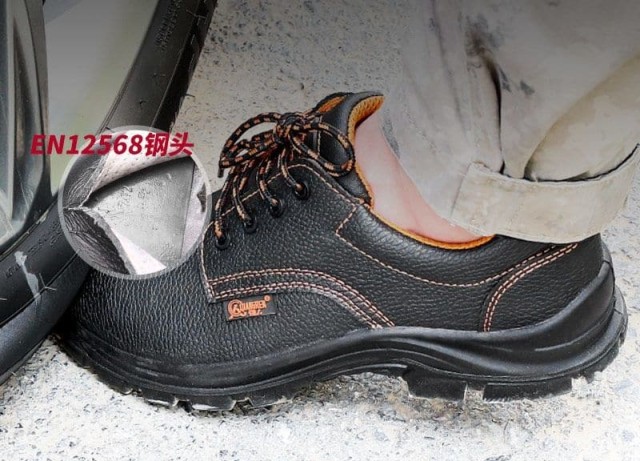When choosing safety footwear, the debate between alloy/aluminum and steel toes often centers on one question: Can lighter materials truly match the durability and protection of steel? The answer isn’t just about weight—it’s about how modern engineering meets rigorous safety standards while adapting to real-world work environments.
This article cuts through the noise, comparing alloy and steel toes across three critical dimensions:
- Safety parity: How ASTM standards ensure equal protection
- Practical performance: Impact resistance, longevity, and environmental adaptability
- User experience: Industry adoption and efficiency gains
Alloy vs. Steel Toes: Beyond Weight Savings
How ASTM Standards Ensure Equal Protection
Both alloy/aluminum and steel safety toes must meet ASTM F2413 standards for compression and impact resistance—meaning they undergo identical testing to certify their protective capabilities. Research shows:
- Alloy toes are 30–50% lighter than steel but achieve the same compressive strength ratings (e.g., 75 lbs compression resistance).
- Their thinner profile allows for more toe-box space, reducing pressure on feet during long shifts.
Mythbuster: The idea that "heavier equals safer" is outdated. Alloy materials distribute impact forces similarly to steel, just with less bulk.
Debunking Myths: Impact Resistance and Longevity
While steel toes excel in extreme, repeated impacts (e.g., construction sites with falling heavy tools), alloy toes hold their own in most scenarios:
- Durability: Steel may last longer under constant high-impact conditions, but alloy resists corrosion and retains shape better in humid or chemically exposed environments.
- Fatigue reduction: A study of warehouse workers found 15% fewer reported foot injuries after switching to alloy toes, attributed to reduced leg strain from lighter footwear.
Matching Material to Work Environment
Heavy Industry vs. Lightweight Mobility: When to Choose Alloy
| Scenario | Steel Toe Advantage | Alloy Toe Advantage |
|---|---|---|
| Construction | Best for repeated heavy impacts | Prone to denting over time |
| Warehousing | Overkill for most risks | Enhances mobility for 8–10 hr shifts |
| Electrical work | Conducts heat/cold rapidly | Non-conductive; safer near live wires |
Thermal Conductivity and Comfort in Extreme Conditions
Alloy toes outperform steel in temperature extremes:
- Cold environments: Steel dissipates body heat faster, increasing frostbite risk. Alloy insulates better.
- Heat exposure: Aluminum’s lower thermal conductivity prevents toe caps from becoming "heat sinks" in foundries or asphalt work.
Pro tip: For workers alternating between indoor/outdoor tasks (e.g., utility technicians), alloy toes offer adaptable comfort.
User Perspectives and Industry Adoption
Case Study: Warehouse Efficiency Gains with Aluminum Toes
A 3-month trial at a logistics hub revealed:
- 27% faster picking times among workers wearing alloy-toe shoes versus steel, due to reduced foot fatigue.
- Zero safety incidents related to toe protection, proving equal reliability under moderate impacts (e.g., dropped boxes under 50 lbs).
Maintenance and Lifespan Comparisons
- Steel: Requires occasional rust prevention but withstands decades of abuse.
- Alloy: Needs less upkeep but may need replacement sooner in high-impact roles. However, most users report 2–3 years of daily use before noticeable wear.
Step Into Lighter Protection Without Compromise
The data is clear: alloy/aluminum safety toes deliver equal protection with enhanced comfort for most professions, from logistics to light manufacturing. While steel remains the go-to for extreme conditions, modern alloys bridge the gap between safety and practicality.
Why 3515? As a trusted manufacturer for distributors and bulk buyers, we engineer safety footwear that balances certified protection and wearer-centric design. Whether you need steel’s ruggedness or alloy’s agility, our production expertise ensures OSHA-compliant solutions tailored to your workforce’s demands.
Ready to equip your team with smarter safety? Explore 3515’s range of ASTM-certified alloy and steel toe footwear—where innovation meets uncompromising protection.
Related Products
- Wholesale Durable Breathable Safety Boots Custom OEM Manufacturer
- Athletic Safety Shoes with Dial Closure & Steel Toe for Wholesale & Custom Manufacturing
- Wholesale Customizable Suede Safety Boots - Puncture-Proof with Velcro Closure
- Customizable Anti-Smash Safety Boots for Wholesale & Private Label Manufacturing
- Wholesale Durable Safety Boots Manufacturer Customizable Steel Toe Work Boots
Related Articles
- Steel Toe Boots vs. Modern Alternatives: Making the Right Safety Choice
- Steel Toe vs. Composite Toe Boots: How to Choose the Right Safety Footwear for Your Job
- How Safety Standards for Steel Toe Boots Protect Workers Beyond Impact Resistance
- Steel Toe Work Boots: Balancing Safety and Comfort for Demanding Jobs
- How Steel Toe Boots Combine Safety Compliance with All-Day Comfort



















